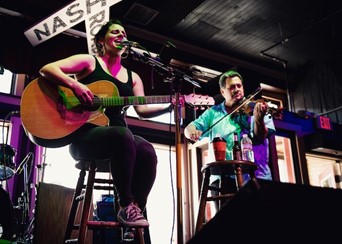Edward Andrew Karpus is a passionate music enthusiast whose love for classic rock, pop, and country runs deep. With an ear finely tuned to the melodic intricacies of these genres, Ed explores the rich tapestry of country music's history. Below, Edward Karpus discusses the evolution of country music, unraveling its beginnings in folk traditions into the renowned Nashville Sound.
Country music: a distinctly American style incorporating folk, rural dance music, bluegrass, and blues elements with origins traced to the late 1920s in the southern Appalachian Mountains. Robust country music scenes stipple the nation, including Oklahoma, Texas, California, and Tennessee. But little do many know that this "traditional USA riff" has British roots.
Edward Karpus explains that the style has come about thanks to pioneers from the British Isles who adventured and remained in the eastern Appalachian mountain range. First dubbed Hillbilly music, the genre originally emerged as an amalgamation of English folk songs and ballads, Scottish-Irish fiddle and dance musics, and African American banjo and blues influences.
Edward Karpus on the Music of the 19th Century
Country Music, Usa by Bill C. Malone takes a conical look at the beginnings of this much-loved genre, and as those who have dived into the pages report, it starts in the fertile lands between Virginia and Texas. Carrying on their religious dissent from Ireland, England, and Scotland, the homesteaders pushed into the backcountry.
And as the nineteenth century came in, the secular music with, as Malone sates, "simple melodies and song texts [with] choruses, refrains, and repetitive phrases," were heard.
Edward Andrew Karpus says that without TVs or radios, singing was a major social activity, accompanied by parlor organs, autoharps, and harmonicas. At this time, gospel music and popular songs were sold as sheet music, giving people access to the latest and greatest tunes.
The Ulster-Scots carried fiddles, folk songs, and worship psalms throughout the Atlantic. However, it's the Scotch-Irish who are most famed for developing distinctive styles of Hillybilly music in the South and Appalachia.
The First Recording
It wasn't until the 1920s that the first recording of old-time country music was created. Played on instruments like the autoharp, fiddle, mandolin, acoustic guitar, and banjo, Carter Family recordings quickly became the most popular.
A. P. Carter, the head of the
Carter Family, collected folk songs and wrote new songs to sing in harmony with his autoharp-playing wife, Sarah, and sister-in-law, Maybelle, who played the guitar. As the first country music stars, their hit records were
Wildwood Flower,
Can The Circle Be Unbroken, and many others.
Edward Karpus also notes that another early star, Jimmi Rodgers, was recorded during the same sessions. African Americans in railroad gangs taught Rodgers how to sing blues and play guitar, so he blended these rhythms with folk songs to create a unique sound. His song,
Blue Yodel, sold almost 500,000 copies in 1927. So, it's perhaps unsurprising that the radio had brought country music to the nation by this point.
The Era of String Bands and Singing Cowboys
Edward Karpus states that the Grand Ole Opry, the Nashville-based radio show that made country music a national favorite, increased its popularity, giving rise to more country bands and singers. Dubbed Western music, artists played songs with horse-like rhythms and lyrics about lovesick cowboys and gun-slinging hooligans.
This unabashed country style was a crowd favorite, thanks to "singing cowboys" like Roy Rogers and Gene Autry. They became massive country music stars, prompting Nashville executives to realize that the cowboy image was a better look for the genre than the hillbilly picture of the '20s.
Edward Andrew Karpus notes that during this time, country-loving string bands comprising fiddles, guitars, banjos, mandolins, and basses performed, creating hits based around their dynamic playing styles. Performing on local radio shows and in honky tonks, artists like Doc Watson and Earl Scruggs became bluegrass country stars.

 The Second Half of the Century
The Second Half of the Century
Edward Andrew Karpus says that at this stage, country music's popularity was booming. The likes of Tammy Wynette, Shania Twait, Garth Brooks, Patsy Cline, and Dolly Parton came to the stage, racking up best-selling albums and Grammy's.
It was around then that the '50s and '60s star, Johnny Cash, decided to develop a subgenre of country, known as outlaw country. It rejected the commercial trappings of the mainstream songs, giving Merle Haggard and Willie Nelson a chance to show the world everything they had.
The Evolution of Nashville Sound
Edward Karpus explains that music is often a fickle industry. And it wasn't too long until the emergence of rock 'n' roll pulled fans from the country music scene. So, producers on Music Row came up with a way to reach a wider audience, adding a few violins, soft piano, and made the vocals front and center. Without even knowing it, they made Nashville sound.

 The Second Half of the Century
The Second Half of the Century